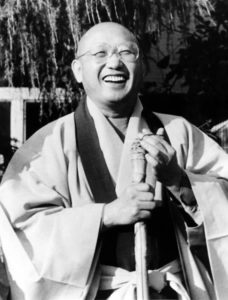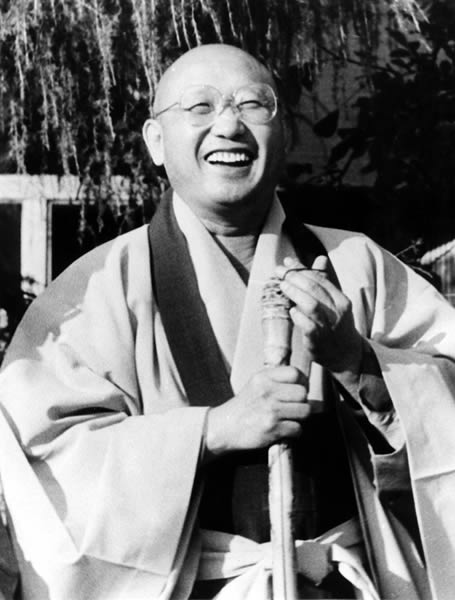#18 WHAT ARE YOU DOING RIGHT NOW?: In Search of Ordinary Mind

Seung Sahn Sunim
I’ve been studying Indian texts on Mahamudra, a superlative statement of the most essential kind of instruction on the very pith of the Buddhist teachings. So when our little on-line study group of old dharma students met last week and got into a discussion of “ordinary mind,” it immediately brought up for me Saraha’s “The People’s Song” (Dohakosha in Sanskrit). Saraha (8th century India) gets cited as the origin of the mahamudra teachings, which describe the essence of enlightenment as “ordinary mind.”
How could this great thing, the solution to it all, enlightenment itself, be “ordinary”? By virtue of it being the fundamental, unchanging reality at the core of all the ever-changing things, it turns out to be the only thing that’s actually “ordinary.” Everything else has some special existence as it comes and goes.
It’s ordinary because it has no special existence or anything that marks it out. Saraha (translated by Karl Brunholzl):
It has neither beginning, nor end, nor middle
It is not conceived as either existence or nirvana
In this supreme and uncontrived great bliss,
there is nothing established as self or other
Saraha can get pretty astringent in his assessment of the many modalities of spiritual practice people pursue; it seems that for him nothing matters but direct experience of ordinary mind or “natural heart”:
As it is free of dhyana [meditation], what’s to be contemplated?
Being inexpressable, what is there to be discussed?
All beings entered the mudra of samsaric existence
Nobody has realized the nature that is native
At the time when the natural heart is experienced,
there is no tantra, no mantra, no mind, and no dhyana
At equality’s time, the nature of all that is delusion’s cause
In other words, once you know the single or equal nature of all phenomena, you’ll recognize how your own religious practice is just “delusion’s cause.” But of course, it seems like in the meantime you’re still stuck with contemplation, meditation, recitation, and all the rest.
That’s the conversation we were having, when I remembered walking down the street on the Hill in Boulder one afternoon circa 1981. Someone called my name–a Zen guy I knew from a dance class at Naropa. He told me that a Korean Zen master would be giving a talk in the evening, and invited me to come.
That was my first experience of Seung Sahn Sunim. In his talk, he described different kinds of thinking. By my recollection, it went something like: thinking, just thinking, not thinking…and maybe there were a couple more. “Just thinking” meant how you would act if the car in front of you pulled up short and you had to pound down the brake with your foot. “Thinking” was what we usually do, while “not thinking” meant thinking had vacated the mind altogether.
After the talk, I went up to him to ask him further about these different kinds of thinking, trying to get a better bead on his explanation. He said something like, “Thinking, just thinking, and not thinking,” adding pointedly, “– which do you prefer?”
Sensing he was drawing me into a trap, I considered that the normal discursive monologue “thinking” described couldn’t be the right mode of meditative equipoise. “Not thinking” seemed too much like the thing you’d want to have happen, since you’re so fucking sick of thinking anyway, so I settled warily on “just thinking” as the middle way.
He raised his arm and exclaimed, “I’ll hit you with my stick!”
Of course right then my mind stopped. I wasn’t thinking, I wasn’t in search of not thinking because I was sick of thinking, and even the foot didn’t hit the brake in “just thinking” mode. He short-circuited the whole thing. And that, ladies and gentlemen (and LGBTQetc.), is ordinary mind. “What’s to be contemplated…what is there to be discussed?”
A good 14 years later, I had moved to South Korea to teach English and came to face my first Christmas there. My friend, Ken Munro–from New Foundland, another Buddhist, and fellow teacher at ELS in a skyscraper on Jong-ro in Seoul– told me about a sesshin (or whatever they call it Korean) that we could attend over Christmas week.
It turned out to be a three month retreat, but they let us in for those seven days, dressed us up in grey monk’s robes, and put us through the paces. We stayed at Hwa Gye Sa, a Buddhist monastery and amazingly quiet place for being in one of the most densely populated urbanscapes on Earth. Fortunately it’s near the base of a mountain that behind it turns into the wooded slopes of Bukhansan National Park.
The day started with 108 bows/prostrations at 3 am, after a solid 4 hours of sleep. That did wake you up pretty good, but then you got the remainder of the hour off, which almost certainly meant that I went back to my pad on the floor in an adjoining room. At 4 am we chanted for forty minutes or so, and then at 5 am we did sitting meditation, aligned with our backs to the center of the room facing the walls. At 6 am work period began.
I had to sweep the balconies of the shrine hall (we practiced in the upper room two stories above the main, very fancy shrine room), as well as the paths and steps of the compound. I could see the lights of Seoul down through the barren trees below, and as I finished up, dawn would come to the winter sky, the day at its start…and already it had seemed like a long one.
As it turned out, this was Seung Sahn Sunim’s monastery (karma, yes?), and he was in town, staying there. This meant every day at 9 am we got a half hour audience with him to ask questions. A few days in, I got up my gumption, stood up, and made my inquiry.
It already seemed obsolete before it was halfway out of my mouth, but I managed to articulate, “How do you recognize the nature of mind?”
He asked, “What are you doing right now?”
“Looking at you,” I said.
“That’s it,” he replied. Our exchange was over.
That’s the thing about ordinary mind (even if this doesn’t exist as a term in Zen), since you can’t nail it to this or that, you can’t really get away from it either. As sentient beings, we externalize everything, so that automatically includes enlightenment as well. It’s been under our noses the whole time, but we always seem to be sniffing out its trail and tracking it through the wilderness. Saraha:
Within seeing, hearing, touching, and thinking,
eating, smelling, and resting during the night,
idle conversations, as well as giving answers,
do not ever go beyond that single essence of
“It’s mind” and native suchness’s dimension!
It’s the suchness of the reality of one’s own mind, right here or on the other side of the planet. Advayavajra, in his commentary on Saraha’s poem, says, “All that is seen, heard, touched, thought, eaten, and smelled by the eyes, the ears, the body, the mind, the tongue, the nose, and so on is the form of the great bliss of the dharmakaya [fully enlightened mind], the sound of suchness, the touch of not being anything whatsoever, the pondering of undifferentiability, the taste of nonduality, and the smell of ordinary mind. All of these are to be enjoyed as mind as such.”
All of these are to be enjoyed! And there you are, of course, doing your wall-gazing, muttering your mantras, sweeping up the balcony, on the knife-edge of whether or not you’ll allow yourself to enjoy your natural mind.

GA as monk, up before dawn at Hwa Gye Sa, 1995


Thanks Gary. An insightful description and story of the nature of mind.
I love the notion of sniffing out the tail of ordinary mind. Thanks Gary.
Great Blog, Gary. I really enjoyed your re-telling of your experience with Seung Sahn Sunim’s “3 thinkings.” I think I would have chosen that one too!
It was a classic double–or triple–bind, with no way out. I stepped right into it.